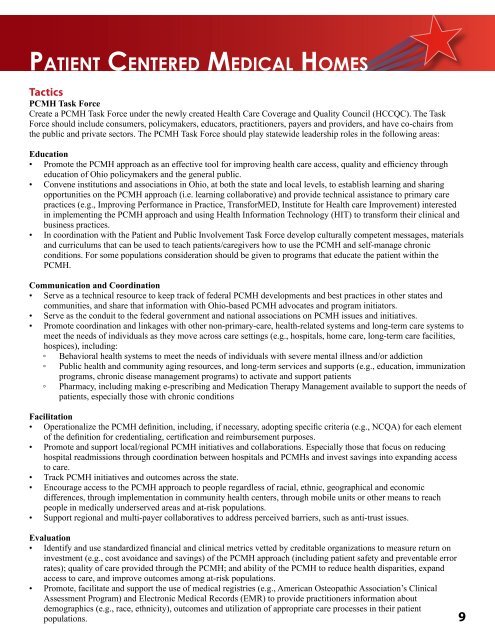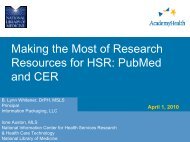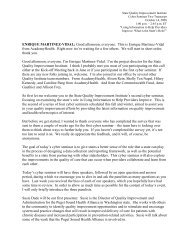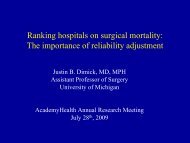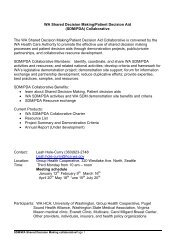Ohio Health Quality Improvement Plan
Ohio Health Quality Improvement Plan
Ohio Health Quality Improvement Plan
Create successful ePaper yourself
Turn your PDF publications into a flip-book with our unique Google optimized e-Paper software.
Pa t ie n t Centered Me d ic a l Ho m e sTacticsPCMH Task ForceCreate a PCMH Task Force under the newly created <strong>Health</strong> Care Coverage and <strong>Quality</strong> Council (HCCQC). The TaskForce should include consumers, policymakers, educators, practitioners, payers and providers, and have co-chairs fromthe public and private sectors. The PCMH Task Force should play statewide leadership roles in the following areas:Education• Promote the PCMH approach as an effective tool for improving health care access, quality and efficiency througheducation of <strong>Ohio</strong> policymakers and the general public.• Convene institutions and associations in <strong>Ohio</strong>, at both the state and local levels, to establish learning and sharingopportunities on the PCMH approach (i.e. learning collaborative) and provide technical assistance to primary carepractices (e.g., Improving Performance in Practice, TransforMED, Institute for <strong>Health</strong> care <strong>Improvement</strong>) interestedin implementing the PCMH approach and using <strong>Health</strong> Information Technology (HIT) to transform their clinical andbusiness practices.• In coordination with the Patient and Public Involvement Task Force develop culturally competent messages, materialsand curriculums that can be used to teach patients/caregivers how to use the PCMH and self-manage chronicconditions. For some populations consideration should be given to programs that educate the patient within thePCMH.Communication and Coordination• Serve as a technical resource to keep track of federal PCMH developments and best practices in other states andcommunities, and share that information with <strong>Ohio</strong>-based PCMH advocates and program initiators.• Serve as the conduit to the federal government and national associations on PCMH issues and initiatives.• Promote coordination and linkages with other non-primary-care, health-related systems and long-term care systems tomeet the needs of individuals as they move across care settings (e.g., hospitals, home care, long-term care facilities,hospices), including:◦◦ Behavioral health systems to meet the needs of individuals with severe mental illness and/or addiction◦◦ Public health and community aging resources, and long-term services and supports (e.g., education, immunizationprograms, chronic disease management programs) to activate and support patients◦◦ Pharmacy, including making e-prescribing and Medication Therapy Management available to support the needs ofpatients, especially those with chronic conditionsFacilitation• Operationalize the PCMH definition, including, if necessary, adopting specific criteria (e.g., NCQA) for each elementof the definition for credentialing, certification and reimbursement purposes.• Promote and support local/regional PCMH initiatives and collaborations. Especially those that focus on reducinghospital readmissions through coordination between hospitals and PCMHs and invest savings into expanding accessto care.• Track PCMH initiatives and outcomes across the state.• Encourage access to the PCMH approach to people regardless of racial, ethnic, geographical and economicdifferences, through implementation in community health centers, through mobile units or other means to reachpeople in medically underserved areas and at-risk populations.• Support regional and multi-payer collaboratives to address perceived barriers, such as anti-trust issues.Evaluation• Identify and use standardized financial and clinical metrics vetted by creditable organizations to measure return oninvestment (e.g., cost avoidance and savings) of the PCMH approach (including patient safety and preventable errorrates); quality of care provided through the PCMH; and ability of the PCMH to reduce health disparities, expandaccess to care, and improve outcomes among at-risk populations.• Promote, facilitate and support the use of medical registries (e.g., American Osteopathic Association’s ClinicalAssessment Program) and Electronic Medical Records (EMR) to provide practitioners information aboutdemographics (e.g., race, ethnicity), outcomes and utilization of appropriate care processes in their patientpopulations.9


